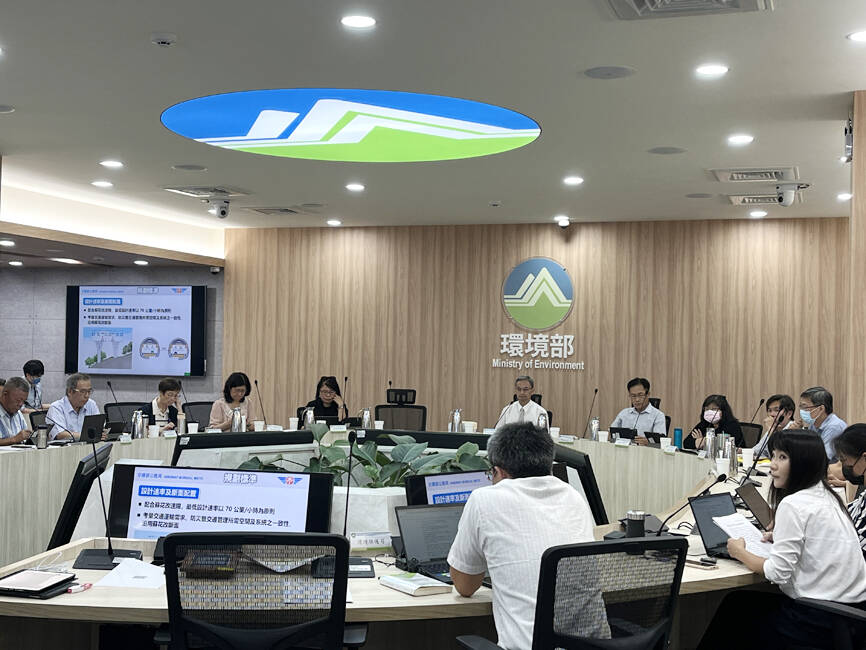The Environmental Impact Assessment (EIA) committee yesterday gave its approval to the Suhua Highway Safety Enhancement Project and a plan to construct a highway connecting the Chiang Wei-shui Memorial Freeway (Freeway No. 5) and Dongao (東澳) in Yilan County, amid concerns by environmental groups that the projects might further damage the region’s fragile topography.
The Highway Bureau in 2020 completed the Suhua Highway Improvement Project, which covered several sections of the highway: between Suao (蘇澳) and Dongao (東澳) in Yilan County; between Nanao (南澳) in Yilan County and Heping Township (和平) in Hualien County; between Hejhong (和中) and Heren (和仁) in Hualien County; and between Heren and Dacingshuei (大清水) in Hualien County.
The new project covers sections that were not included in the previous project: between Dongao (東澳) and Nanao (南澳), between Heping and Hejhong, and from Heren to Jhongde (崇德) via Dacingshuei.

Photo courtesy of the Environmental Impact Assessment Committee
The Dongao-Nanao section is about 9.3km long, while Heping to Hejhong is about 5.5km. The longest section is from Heren to Jhongde via Dacingshuei, which is about 15.1km.
‘TAROKO’ TUNNEL
The construction of all three sections would involve drilling tunnels and building bridges. For the longest section of the project, a tunnel would be drilled through Taroko National Park.

Photo: Chen Chia-yi, Taipei Times
Enhancing the safety of the three sections that were not covered by previous projects is necessary, as they have been increasingly damaged by typhoons and heavy rainfall due to extreme weather, Highway Bureau Director-General Chen Wen-juei (陳文瑞) told the committee.
An earthquake measuring 7.2 on the Richter scale that struck Hualien in April did not affect sections of the Suhua Highway Improvement Project, but it caused landslides at the Heping-Hejhong section and the Heren-Jhongde sections, and crushed one of the bridges there, Chen said.
“The safety of the sections in the previous project was not compromised even when the nation was under the influence of Typhoon Gaemi, but it caused mudflow at the tunnel in Jhongde,” Chen said.
“We hope that the safety of the remaining sections can be improved through the methods used in the Suhua Highway Improvement Project, so that people can have safe and reliable road access all day between Taipei and Hualien,” he added.
Wild at Heart Legal Defense Association researcher Hong Shuo-cheng (洪碩辰) told the committee that improving the safety of the Dongao-Nanao section is not as urgent, as it has experienced fewer landslides and traffic accidents compared with other sections.
GEOLOGICAL SURVEYS
Environmental Rights Foundation executive director Tu Yo-wen (?又文) said that the project needs a Phase II environmental impact assessment, as questions remain on whether sufficient geological surveys have been conducted given the complex topography of the area.
The costs, technology and construction safety risks involved in the project are much higher and more complex than other freeways and expressways, Tu said.
Both organizations said the construction areas contain rich sources of underground water, but the bureau does not have plans on how to reuse water that might gush out during construction.
Earth excavated during construction is to be transported to Yilan, which is already burdened by the previous project, they said.
The committee approved the project on the condition that the earth removed by the new project can only be stored in Yilan for one year.
The committee also approved the bureau’s proposal to construct a 7.1km-long highway to connect Freeway No. 5 and Dongao to ease traffic congestion in downtown Suao during holidays.
As there is no road access connecting the freeway and sections of the Suhua Highway Improvement Project, motorists traveling to Hualien must get off at the Suao Interchange on the freeway and drive to Dongao via downtown Suao.
This has caused severe traffic congestion in Suao, particularly on weekends and holidays.
The highway would connect the Suao Interchange and Dongao directly. The construction is estimated to cost about NT$27.2 billion (US$832 million).

SECURITY: As China is ‘reshaping’ Hong Kong’s population, Taiwan must raise the eligibility threshold for applications from Hong Kongers, Chiu Chui-cheng said When Hong Kong and Macau citizens apply for residency in Taiwan, it would be under a new category that includes a “national security observation period,” Mainland Affairs Council (MAC) Minister Chiu Chui-cheng (邱垂正) said yesterday. President William Lai (賴清德) on March 13 announced 17 strategies to counter China’s aggression toward Taiwan, including incorporating national security considerations into the review process for residency applications from Hong Kong and Macau citizens. The situation in Hong Kong is constantly changing, Chiu said to media yesterday on the sidelines of the Taipei Technology Run hosted by the Taipei Neihu Technology Park Development Association. With

CARROT AND STICK: While unrelenting in its military threats, China attracted nearly 40,000 Taiwanese to over 400 business events last year Nearly 40,000 Taiwanese last year joined industry events in China, such as conferences and trade fairs, supported by the Chinese government, a study showed yesterday, as Beijing ramps up a charm offensive toward Taipei alongside military pressure. China has long taken a carrot-and-stick approach to Taiwan, threatening it with the prospect of military action while reaching out to those it believes are amenable to Beijing’s point of view. Taiwanese security officials are wary of what they see as Beijing’s influence campaigns to sway public opinion after Taipei and Beijing gradually resumed travel links halted by the COVID-19 pandemic, but the scale of

A US Marine Corps regiment equipped with Naval Strike Missiles (NSM) is set to participate in the upcoming Balikatan 25 exercise in the Luzon Strait, marking the system’s first-ever deployment in the Philippines. US and Philippine officials have separately confirmed that the Navy Marine Expeditionary Ship Interdiction System (NMESIS) — the mobile launch platform for the Naval Strike Missile — would take part in the joint exercise. The missiles are being deployed to “a strategic first island chain chokepoint” in the waters between Taiwan proper and the Philippines, US-based Naval News reported. “The Luzon Strait and Bashi Channel represent a critical access

Pope Francis is be laid to rest on Saturday after lying in state for three days in St Peter’s Basilica, where the faithful are expected to flock to pay their respects to history’s first Latin American pontiff. The cardinals met yesterday in the Vatican’s synod hall to chart the next steps before a conclave begins to choose Francis’ successor, as condolences poured in from around the world. According to current norms, the conclave must begin between May 5 and 10. The cardinals set the funeral for Saturday at 10am in St Peter’s Square, to be celebrated by the dean of the College